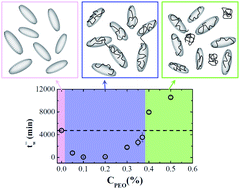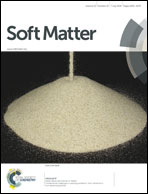Dual aging behaviour in a clay–polymer dispersion
Abstract
Clay–polymer compounds have recently attracted increasing attention due to their intriguing physical properties in colloidal science and their rheological non-trivial behaviour in technological applications. Aqueous solutions of Laponite clay spontaneously age from a liquid up to an arrested state of different nature (gel or glass) depending on the colloidal volume fraction and ionic strength. We have investigated, through dynamic light scattering, how the aging dynamics of Laponite dispersions at fixed clay concentration (Cw = 2.0%) is modified by the addition of various amounts of poly(ethylene oxide) (PEO) (CPEO = (0.05 ÷ 0.50) %) at two different molecular weights (Mw = 100 kg mol−1 and Mw = 200 kg mol−1). A surprising and intriguing phenomenon has been observed: the existence of a critical polymer concentration C*PEO that discriminates between two different aging dynamics. With respect to pure Laponite systems the aging will be assisted (faster) or hindered (slower) for PEO concentrations respectively lower (CPEO < C*PEO) or higher (CPEO > C*PEO) than the critical concentration. In this way a control on the aging dynamics of PEO–Laponite systems is obtained. A possible explanation based on the balance of competitive mechanisms related to the progressive saturation of the clay surface by polymers is proposed. This study shows how a real control on the aging speed of the PEO–Laponite system is at hand and renders possible a real control of the complex interparticle interaction potential.


 Please wait while we load your content...
Please wait while we load your content...